Insect & Disease Conditions Update
A printer-friendly version of this report is available on-line from the Conditions Report Index.
This is the first edition of the Forest & Shade Tree - Insect &
Disease Conditions for Maine report for 2017. Spring clean-up is a good way to start a
healthy 2017 growing season. In case you were not able to get to it in the fall,
cleaning up leaf debris and pruning dead wood from trees decreases the potential
for disease and insects to harm trees. Avoid pruning living tree parts to
prevent creating entry points for diseases to enter and become established and
to avoid attracting unwanted insects. Look out for silvery browntail moth webs
at the tips of hardwood branches and prune them out, destroying the webs by
submerging them for 24 hours in a bucket of soapy water or by burning them.
Unwrap and unshade trees protected in the fall. Spring is also an excellent
time to plant most tree species, of course keeping in mind a ‘right tree for
the right place’ philosophy. A lot can happen in the woods over winter, so take
an opportunity to get out and inspect for changes to your woodlot, such as blow
downs and other damage that occurred over the winter. Salvaging severely damaged trees and clearing
paths may be in order.
Our
business hours for 2017 will be 7:30 a.m. to 4:00 p.m. Monday through Friday,
except for holidays. However, due to a
very busy field schedule, we may not be able to staff the Insect and Disease
Lab at all times. If you call our Lab and receive no answer, please call back
another time.
If you
have questions on insect and disease pests of trees, you can submit a clinic
form directly on-line.
We will also accept samples mailed in to our Lab in Augusta. Our street address and location remains the
same (50 Hospital Street, Augusta); our mailing address is 168 State House Station, Augusta, 04333-0168.
Allison Kanoti is
at the Old Town Regional Office: Phone (207) 827-1813; Fax (207) 827-8441; Mailing
Address MFS, PO Box 415, Old Town, ME 04468; Physical address: 87 Airport Road.
If you plan to
visit either office, you may wish to call ahead just to make sure someone will
be present to meet with you.
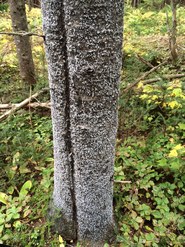 Balsam Woolly Adelgid (Adelges piceae)
–Balsam woolly adelgid is established throughout Maine, and
has been since the middle of the last century.
Damage is less significant in areas of the state where cold winter
temperatures limit buildup of populations.
However, notable damage has a history even in areas we often consider
immune from cold-intolerant insects, such as the area around Moosehead
Lake. Last year balsam woolly adelgid
populations were elevated in many areas of the state. Populations build following moderate winters,
especially in the absence of late spring frosts. Be alert for signs and
symptoms of damage on fir in forest and ornamental settings.
Photo: Balsam woolly adelgid trunk phase (A. Wopat, Weyerhaeuser).
When this non-native insect attaches to the host-tree it
induces a hypersensitive response, causing a change in the cells produced by
the tree. The abnormal cells do not
conduct water well which leads to a physiological drought in the tree. Dry growing seasons can exacerbate the
impacts of balsam woolly adelgid.
Crowns of impacted trees may be noticeably distorted or may just appear
thin. Like other adelgids, the eggs,
nymphs and adults of this insect are covered in a waxy flocculence. This
material may persist after the insect is gone.
Trees that have had heavy trunk attack will be brittle and more prone to
breakage; abnormal growth rings (large, red) may be visible in cut trees.
Although this is an invasive insect of consequence, there
are not many options for response.
Awareness of the problem, adaptive management in response to building
populations and shorter rotations of fir-dominated stands can help mitigate
impacts. Targeted removal of heavily
infested trees may reduce populations in forest stands. To be most effective, removals should take
place before eggs are present (getting late for this year).
|
Browntail Moth (Euproctis chrysorrhoea) – Once again browntail moth tops the list of Most Dreaded Forest Insects in Maine. As reported last fall over 63,000 acres of forest in Sagadahoc County and surrounding towns were defoliated by the tiny, early-instar larvae of browntail moth in August and September. The winter web survey conducted by the Maine Forest Service found that the population has expanded as expected and has moved further Downeast onto the islands east of Rockland and Belfast and to the Deer Isle area (see map). The infestation tapers off as you move away from the core area centered on Sagadahoc County. Populations are expected to be scattered and light in new locations but people should still be aware of them.
 If webs can be pruned out of trees (do it NOW) in these
areas then the infestation can be slowed. The caterpillars (two red dots on
their hind end) are starting to emerge so time is of the essence. Look on the
TIPS of branches for leaves webbed together with bright white silk into a very
tight web usually 3–6 inches long – these hold the overwintering caterpillars.
If the browntail moth overwintering webs are within reach then they can be cut
out and destroyed. These are not the filmy webs now showing in up in the
crotches of fruit trees. Those webs are made by eastern tent caterpillar and
that have started to emerge and build THEIR webs (see page 4).
For people in areas infested with browntail moth, use
caution when cleaning yards and gardens, raking, weed-whacking, leaf blowing,
removing brush, etc., as the toxin in the browntail moth hairs that can cause
rashes and respiratory symptoms in humans stays active for up to three years.
More detailed information can be found on our website.
Emerald Ash Borer (Agrilus planipennis) – Emerald ash borer (EAB) has not yet been found in Maine. Even though this destructive insect has been on our doorstep for a few years, it is still too early to be treating specimen ash with pesticides to protect them from this pest. Experts recommend holding off treatment until the EAB is within 10–15 miles of the trees in question. In the meantime, resources are better spent on inventorying ash and surveying and monitoring for the pest.
Ash phenology gives us a great opportunity to conduct surveys as hardwood leaves emerge. Ash are among the last to leaf out (black locust is another slow-poke), and because of this characteristic they are easily recognized after other hardwood leaves have flushed. An ash inventory can be as simple as a windshield survey to determine whether you have a lot of ash to worry about or just a few. For more in-depth inventories, consider recording location, size, value and likely management approach for each tree. Check out the nhbugs.org site on EAB for some succinct advice on preparing for this pest in areas more than 10 miles from known infestations.
If you are a landowner and have ash trees on your land, consider creating a girdled trap tree to monitor for EAB. All trap trees girdled last year were negative for signs of EAB and efforts have begun this year to girdle trees to continue monitoring. If you have an ash tree of any species (not mountain ash) over four inches in diameter at 4.5 feet that you would be willing to sacrifice as a trap tree, please email Colleen Teerling with the subject line “Trap Tree” and we will help you create a trap tree. More information can be found on our website.
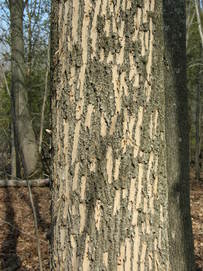 This is one of the best times of year to watch for signs of EAB. During the winter until the trees start to leaf out in the spring, woodpeckers often find and feed on overwintering EAB larvae, which are nice and fat and make good eating at this time of year. As the birds feed, they flick off the gray outer bark, and expose the light-blond inner bark, leaving a distinctive signature (although not unique to woodpeckers feeding on EAB). It is primarily the smaller woodpeckers, like the hairy and the downy, that feed on EAB; although even smaller birds like nuthatches do as well. When you are out and about, watch for signs of woodpecker feeding on ash and let us know if you see any. If you can, take a picture of any feeding you see on ash and pass it on to us.
Photo: Evidence of woodpecker feeding on ash (Maine
Forest Service).
|
 Eastern Tent Caterpillar (Malacosoma americanum) – Watch for
the developing tents of these hairy caterpillars in cherries and apples in late
April and early May in southern Maine (later as you move farther north. Eggs began hatch this year around April 16th
in Old Town). In Maine, this is
primarily a nuisance and aesthetic pest.
It does not significantly impact forest health, but repeated defoliation
can affect host growth and vigor, which can be especially important on
ornamental and orchard trees. On valued fruit and ornamental trees, you can
look for and destroy egg masses of this caterpillar. Also monitor for developing tents on these
trees and consider removing them when they are small. The caterpillars return
to their tents in the evening so this and early morning are good times to
remove tents.
Photo: Eastern tent caterpillar web (Maine Forest Service)
Ground-Nesting Bees – Beginning in very early
spring, solitary ground-dwelling bees emerge and become active. When they first
emerge they are usually very active, with much flying around, mating,
exploration and nest-building. As people increase their yard-work activities,
they begin to notice the bees. All the activity by bees can look frightening.
However, solitary bees (one nest for each female, although you may have many
nests in one area) are generally non-aggressive and will not sting unless
severely harassed. The males often look aggressive while they fly around
searching for a mate, but they can’t sting at all. This heightened activity
persists for only a week or two, and then the bees are almost unnoticeable.
Ground nesting bees are valuable pollinators.
|
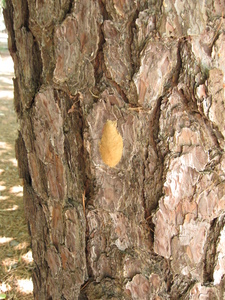 Gypsy Moth (Lymantria dispar) – You still have some time to
search for and remove gypsy moth egg masses; but time is running short in
southern Maine. You can scrape and soak
the egg masses in soapy water or treat them with horticultural oil in
place. If you are finding lots of egg
masses (more than you can count on your fingers) around your home, let us know
– any photos, about how many, in what size plot of land, and where – your
information can help us focus survey efforts to areas we might not otherwise
visit. Please let us know if you think you have found egg masses outside the
gypsy moth quarantine area. You can send this information to
Allison Kanoti or call (207) 827-1813. The process for revising the quarantine has
started and we’ll be keeping you up-to-date on progress through the Conditions
Reports.
Photo: Gypsy moth egg mass (Maine Forest Service).
Hemlock Woolly Adelgid (Adelges tsugae) – Hemlock woolly
adelgid (HWA) eggs and/or crawlers (mobile stage of HWA) are now present and
will be more or less continuously present until late July or early August.
These life-stages can be spread on items other than the host trees (clothing,
equipment, pets, etc.). If possible,
postpone work in infested hemlock stands until August to reduce spread of
HWA. Remember that HWA is a quarantined
pest. All products may move freely
within the quarantined area. Roundwood
products such as logs and pulp may be moved freely within Maine, but must be
free from branches. Material with branches, such as chips, moved outside the
quarantine area must go to facilities with agreements to receive that material.
Quarantine regulations are slightly different in neighboring New Hampshire and
Vermont.
|
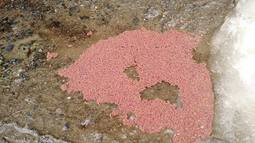 Springtails (Collembola) – A homeowner in Monson took note
of some springtails springing up in the driveway earlier this month. A picture was shared with the Maine Forest
Service Forest Rangers on Facebook and forwarded to us for identification. Springtails are not harmful, in fact they are
beneficial, and should be left alone.
Some species can become a nuisance in homes where moisture is a problem. In those cases, when the moisture issue is addressed, the springtails will be
eliminated.
Photo: Springtails in Monson (Source: @MaineForestRangers
Facebook)
|
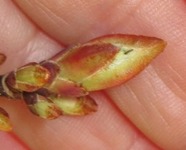 Winter Moth (Operophtera brumata) – The tiny winter moth
caterpillars will soon be hatching and mining the buds of hardwood trees. The easiest way to track down the larvae at
this stage is to inspect host buds for silk and specks of frass. Wait a few weeks, and the signature feeding
damage will be evident on expanded host leaves.
Like the cuts in a paper snowflake, the larval bites make holes through
several layers of leaf tissue, giving the unfurled leaves a Swiss cheese-like
appearance. Caterpillars will finish
feeding by the end of May or early June and drop to the soil where they will
pupate and spend the summer and fall.
Photo: First instar
winter moth caterpillar on an expanding maple bud (Maine Forest Service).
Surveys and reports of adult winter moths flying in December
of 2016 indicate that winter moth numbers are up in some places and down in
others. Expect defoliation this year in places that have had winter moth in the
past with their presence extending into surrounding areas.
Places with significant numbers of moths caught or reported
were Eliot, Kittery, South Berwick, York (York County); Cape Elizabeth,
Harpswell, Portland, Scarborough, South Portland (Cumberland County); Arrowsic,
Bath, Georgetown (Sagadahoc County); Boothbay Harbor (Lincoln) and Vinalhaven
(Knox County). A risk map for winter moth can be found on our website.
Winter moth eggs that are exposed on trees can be killed
with horticultural oil, which suffocates the eggs. Oil should be applied in
very late winter or very early spring when temperatures are above 45° F. Avoid applying oil when temperatures may dip
below freezing for 24–48 hours after application (Cold greatly increases the
risk of causing injury to the plant (phytotoxicity)). Cool and cloudy weather can delay drying time
and increase the potential for injury. This year this treatment needs to happen
immediately.
Eggs that are protectively hidden within crevices and under
lichen will not be covered by the spray nor killed. Where there is heavy winter
moth pressure the oil sprays will most likely only achieve limited results;
eggs are deposited virtually everywhere on trees and shrubs and new
caterpillars will quickly migrate from the oil-treated plants to untreated
areas.
Once the larvae hatch and leaves begin to expand in early
May, trees can be treated with the biological insecticide Bacillus thuringiensis
(kurstaki strain) (B.t.k). B.t.k. works best on young larvae; older ones are
much less affected. For older larvae,
use a spinosad product. As a last resort a conventional insecticide such as
products containing permethrin are effective against winter moth larvae.
The biological control tachinid fly, Cyzenis albicans, was
released in Kittery, Vinalhaven, Harpswell, Cape Elizabeth and Portland (Peaks
Island) between 2013 and 2015. Flies were recovered from Kittery and Cape
Elizabeth in 2016 indicating that the parasitoid has become established in
those two locations. Hopefully flies will be found in the other locations as
well. For those unlucky winter moths that get attacked, the fly will develop
within the winter moth cocoon, and prevent the winter moth from developing to
adulthood. Parasites will continue to be released by the Maine Forest Service
where winter moth populations are high enough to support the control agent.
We continue to look for Bruce spanworm (Operophtera
bruceata) outbreaks. This insect is a native that is closely related to the
invasive winter moth and we would like to be able to study what keeps it under
control. If you see early-season defoliation away from the coast please contact
us.
|
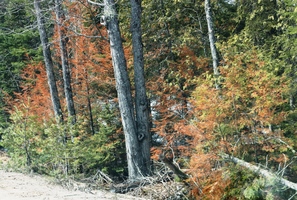 Winter desiccation (drying), winter-burn and salt damage – Winter desiccation naturally occurs each
winter when tree parts (often fine twigs or wounded areas) and evergreen foliage
are exposed to cold temperatures and higher winds. In spring, winter-burn
symptoms result and intensify when a plant is unable to replace moisture lost
from evergreen foliage when warm temperatures initiate photosynthesis while the
ground remains frozen (stomata open for gas exchange, letting water out of the
tissue). These symptoms and the damage caused are made significantly more
severe if roadside deicing chemicals have been splashed onto or carried to
trees as wind-driven mists. Thus, damage is most commonly seen affecting
trees along well-travelled roadways, and especially those growing on low or wet
sites, where roots are shallow, salts may accumulate and the ground remains deeply
frozen for a longer duration. Look for signs of orange or browning
of foliage late in winter, particularly following periods of warm-up and
especially affecting trees receiving elevated levels of transmitted/reflected
heat and light (often first seen on the south side of trees). While all evergreens are more-or-less equally
susceptible to winter-burn, as a tree’s location is the most significant factor
determining the degree of damage, trees have varying levels of salt
tolerance. White pine and particularly
hemlock trees are sensitive to salts. Anecdotal information and observations from
this winter and spring indicate that the liquid/brine deicing formulations may
result in higher levels of roadside tree damage.
Photo: Roadside hemlock trees showing signs of salt damage
in Belgrade (Maine Forest Service)
Under optimal weather conditions for winter-burn
in the natural environment, little can be done to limit the impact of this
disorder, aside from preventative measures already taken in the fall and winter
(wrapping trees, shading trees, using deicing materials with care). While damage from winter desiccation can
adversely affect tree growth and vigor, most trees will recover quickly when
new foliage begins to develop in spring. If the damage was severe enough
to kill buds, recovery will be significantly slower. A check of bud
vitality can give a rapid indication of damage severity (unaffected branch tips
and buds should be bright green under the bark or bud scales). Conversely,
when salts accumulate in low-lying roadside areas, little can be done to
ameliorate this and severe decline and mortality are often the end result.
|
May 2, 3, 4 – A
forest health update will be provided to Stewardship Foresters at the annual
training sessions in Bangor, Scarborough and Augusta.
Conditions Report No. 1, 2017
http://maine.gov/dacf/mfs/publications/condition_reports.html
Department of
Agriculture Conservation & Forestry
Maine Forest Service - Forest Health and Monitoring
Contributors: Aaron Bergdahl, Charlene Donahue, Allison
Kanoti, Colleen Teerling
|